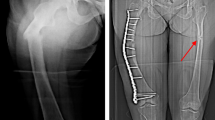Abstract
Summary
In X-linked hypophosphatemic (XLH) rickets, dual-energy X-ray absorptiometry (DXA) measurements must be analyzed with caution. High-resolution peripheral quantitative computed tomography (HR-pQCT) analysis suggested that XLH primarily affects the cancellous compartment, with the tibia more affected than the radius. Effective treatment of XLH appears to positively affect bone mineralization, mainly in the bone cortex.
Introduction
The purpose of this study is to evaluate bone mineral density (BMD) and microarchitecture in 37 patients (13 children and 24 adults) with XLH confirmed by PHEX mutations from a tertiary center compared to healthy controls.
Methods
Areal BMD (aBMD) was evaluated by DXA, whereas volumetric BMD (vBMD) and microarchitectural parameters were analyzed by HR-pQCT.
Results
Adult XLH patients had higher lumbar aBMD (p < 0.01) than the controls. At the radius, the vBMD was similar between XLH patients and controls. At the tibia, XLH patients had lower total vBMD (p = 0.04), likely resulting from decreased trabecular vBMD (p < 0.01), and this difference was observed in the children and adult groups. Analysis based on metabolic status showed that the adult XLH patients with non-compensated disease had lower cortical vBMD at the tibia than the compensated XLH patients (p = 0.03). The microarchitectural differences at the radius and tibia included lower trabecular number (p < 0.01), greater trabecular separation (p < 0.01), and higher trabecular network inhomogeneity (p < 0.01) in XLH patients compared to their controls. At the radius, adults exhibited greater trabecular deficits than were seen in children.
Conclusions
In XLH patients, DXA measurements must be analyzed with caution due to the interference of anatomic and anthropometric factors. HR-pQCT analysis suggested that XLH primarily affects the cancellous compartment, with the tibia more affected than the radius. Effective treatment of XLH appears to positively affect bone mineralization, mainly in the bone cortex.
Similar content being viewed by others
References
The HYP Consortium (1995) A gene (PEX) with homologies to endopeptidases is mutated in patients with X-linked hypophosphatemic rickets. Nat Genet 11:130–136. doi:10.1038/ng1095-130
Yu X, White KE (2005) FGF23 and disorders of phosphate homeostasis. Cytokine Growth Factor Rev 16:221–232. doi:10.1016/j.cytogfr.2005.01.002
Carpenter TO, Imel EA, Holm IA, Jan de Beur SM, Insogna KL (2011) A clinician’s guide to X-linked hypophosphatemia. J Bone Miner Res 26:1381–1388. doi:10.1002/jbmr.340
Beck-Nielsen SS, Brixen K, Gram J, Molgaard C (2013) High bone mineral apparent density in children with X-linked hypophosphatemia. Osteoporos Int 24:2215–2221. doi:10.1007/s00198-013-2286-9
Cheung M, Roschger P, Klaushofer K, Veilleux LN, Roughley P, Glorieux FH, Rauch F (2013) Cortical and trabecular bone density in X-linked hypophosphatemic rickets. J Clin Endocrinol Metab 98:E954–E961. doi:10.1210/jc.2012-4133
Shanbhogue VV, Hansen S, Folkestad L, Brixen K, Beck-Nielsen SS (2015) Bone geometry, volumetric density, microarchitecture, and estimated bone strength assessed by HR-pQCT in adult patients with hypophosphatemic rickets. J Bone Miner Res 30:176–183. doi:10.1002/jbmr.2310
Veilleux LN, Cheung MS, Glorieux FH, Rauch F (2013) The muscle-bone relationship in X-linked hypophosphatemic rickets. J Clin Endocrinol Metab 98:E990–E995. doi:10.1210/jc.2012-4146
Leaf DE, Pereira RC, Bazari H, Juppner H (2013) Oncogenic osteomalacia due to FGF23-expressing colon adenocarcinoma. J Clin Endocrinol Metab 98:887–891. doi:10.1210/jc.2012-3473
Cheung AM, Adachi JD, Hanley DA, Kendler DL, Davison KS, Josse R, Brown JP, Ste-Marie LG, Kremer R, Erlandson MC, Dian L, Burghardt AJ, Boyd SK (2013) High-resolution peripheral quantitative computed tomography for the assessment of bone strength and structure: a review by the Canadian Bone Strength Working Group. Curr Osteoporos Rep 11:136–146. doi:10.1007/s11914-013-0140-9
Cohen A, Dempster DW, Muller R, Guo XE, Nickolas TL, Liu XS, Zhang XH, Wirth AJ, van Lenthe GH, Kohler T, McMahon DJ, Zhou H, Rubin MR, Bilezikian JP, Lappe JM, Recker RR, Shane E (2010) Assessment of trabecular and cortical architecture and mechanical competence of bone by high-resolution peripheral computed tomography: comparison with transiliac bone biopsy. Osteoporos Int 21:263–273. doi:10.1007/s00198-009-0945-7
Beck-Nielsen SS, Brusgaard K, Rasmussen LM, Brixen K, Brock-Jacobsen B, Poulsen MR, Vestergaard P, Ralston SH, Albagha OM, Poulsen S, Haubek D, Gjorup H, Hintze H, Andersen MG, Heickendorff L, Hjelmborg J, Gram J (2010) Phenotype presentation of hypophosphatemic rickets in adults. Calcif Tissue Int 87:108–119. doi:10.1007/s00223-010-9373-0
Rauch F (2006) Material matters: a mechanostat-based perspective on bone development in osteogenesis imperfecta and hypophosphatemic rickets. J Musculoskelet Neuronal Interact 6:142–146
Shore RM, Langman CB, Poznanski AK (2000) Lumbar and radial bone mineral density in children and adolescents with X-linked hypophosphatemia: evaluation with dual X-ray absorptiometry. Skelet Radiol 29:90–93
Baroncelli GI, Bertelloni S, Ceccarelli C, Saggese G (2001) Effect of growth hormone treatment on final height, phosphate metabolism, and bone mineral density in children with X-linked hypophosphatemic rickets. J Pediatr 138:236–243. doi:10.1067/mpd.2001.108955
Oliveri MB, Cassinelli H, Bergada C, Mautalen CA (1991) Bone mineral density of the spine and radius shaft in children with X-linked hypophosphatemic rickets (XLH). Bone Miner 12:91–100. doi:10.1016/0169-6009(91)90038-2
Reid IR, Murphy WA, Hardy DC, Teitelbaum SL, Bergfeld MA, Whyte MP (1991) X-linked hypophosphatemia: skeletal mass in adults assessed by histomorphometry, computed tomography, and absorptiometry. Am J Med 90:63–69
Bouxsein ML, Karasik D (2006) Bone geometry and skeletal fragility. Curr Osteoporos Rep 4:49–56
Li H, Martin A, David V, Quarles LD (2011) Compound deletion of Fgfr3 and Fgfr4 partially rescues the Hyp mouse phenotype. Am J Physiol Endocrinol Metab 300:E508–E517. doi:10.1152/ajpendo.00499.2010
Acknowledgements
We would like to thank all the patients and family members for their participation, Vinícius Nahime Brito for his statistical advice, Pedro Henrique Correa for his guidance, and Berenice Bilharinho Mendonca for technical support.
Author information
Authors and Affiliations
Corresponding author
Ethics declarations
Institutional review board approval from the local ethics committee was obtained for this study. All the patients or their legal representatives provided written informed consent for study participation.
Conflicts of interest
None.
Rights and permissions
About this article
Cite this article
Colares Neto, G.P., Pereira, R.M.R., Alvarenga, J.C. et al. Evaluation of bone mineral density and microarchitectural parameters by DXA and HR-pQCT in 37 children and adults with X-linked hypophosphatemic rickets. Osteoporos Int 28, 1685–1692 (2017). https://doi.org/10.1007/s00198-017-3949-8
Received:
Accepted:
Published:
Issue Date:
DOI: https://doi.org/10.1007/s00198-017-3949-8




